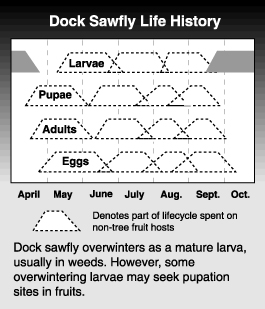by Elizabeth H. Beers and Phil VanBuskirk, originally published 1993
Ametastegia glabrata (Fallén) (Hymenoptera: Tenthredinidae)

Dock sawfly, or dock falseworm, lives on weeds found in orchards. It damages fruit when it tunnels into the flesh in search of a hibernation site. Damage to tree fruits in Pacific Northwest orchards is minor and sporadic, although in the past it has caused substantial injury. The insect originated in Europe and was first described in the United States in 1862. Damage in Washington was first noted in 1903. Its distribution is in the northern United States from coast to coast and in the southern Canadian provinces.
Hosts
Larvae feed on herbaceous plants in the buckwheat family, such as dock, sorrel, knotweed, bindweed and wild buckwheat. The final instar may seek a pupation or hibernation site in a place other than its food plant.
Life stages
Egg
The egg is kidney shaped, somewhat flattened, pearly white, and about 1/32 inch (0.8 mm) long.

Larva
The larva is eruciform (see Sawflies in general), ranging from about 1/10 inch (2.5 mm) for the first instar to 2/3 inch (14 to 17 mm) in the final two instars. Color of early instars is variable butranges from grayish to yellowish green. The final instar ranges from apple green to olive or blue-green, with the ventral side lighter in color than the dorsal side. It has a brownish head, conspicuous white tubercles on its body, and seven pairs of abdominal prolegs.
Pupa
The pupa is greenish at first, gradually darkening to dark brown or black. The female can be distinguished by the saw-like serrations on the ovipositor.
Adult
The adult is a blue-black wasp, about 1/3 inch (7 mm) long, with reddish legs. It is a typical sawfly.
Life history
 Dock sawfly overwinters as a mature larva, usually in the dry pithy stem of a weed host but occasionally in fruits. Larvae pupate in early spring, and adults emerge over a fairly long period (about 7 weeks), with peak emergence in late April.
Dock sawfly overwinters as a mature larva, usually in the dry pithy stem of a weed host but occasionally in fruits. Larvae pupate in early spring, and adults emerge over a fairly long period (about 7 weeks), with peak emergence in late April.
Adults have a life span of about 13 days. They mate, and females lay eggs singly in leaf tissue of the weed host. Females can lay over 100 eggs, which require about 10 days to hatch. The total life cycle, from egg deposition to adult emergence, takes about 52 days for the spring generation. The second and third generations require less time – about 31 and 27 days, respectively.
First instar larvae skeletonize the leaf, but later instars eat large holes in the leaf. The larvae pass through six instars, but the final instar does not feed. Instead, it seeks a pupation site in the stem of the host. Fourth generation larvae are the overwintering larvae.
Damage

Fruit damage caused by the larva looks similar to that of the codling moth larva from the outside, except the characteristic frass is missing.
The entry hole is about 1/12 inch (2 mm) in diameter, often surrounded by a reddish ring. The larva excavates a neat chamber in the flesh of the fruit about the same dimensions as its body. Entries are often found on the cheek of the fruit. A single larva may bore several holes in one or more fruits before constructing its final chamber. Injured fruits may be invaded by decay fungi.
Monitoring
No sampling schemes exist for dock sawfly, nor is monitoring necessary unless the orchard has a history of damage. Typically, infested fruits are those that were hanging down into weeds on the orchard floor. Weed hosts may be examined for larvae near fruit harvest. Examining fruit in the bins for the circular entrance holes will help diagnose the problem, but the damage will have been done.
Management
Dock sawfly is rarely a problem in orchards where weeds are controlled conscientiously. Insecticides applied to control a range of orchard pests usually keep this insect under control. Opening the lower nozzles of the airblast sprayer will help suppress populations. Mowing, herbicides, and limb propping will also reduce fruit infestation by reducing contact of fruit and weeds.